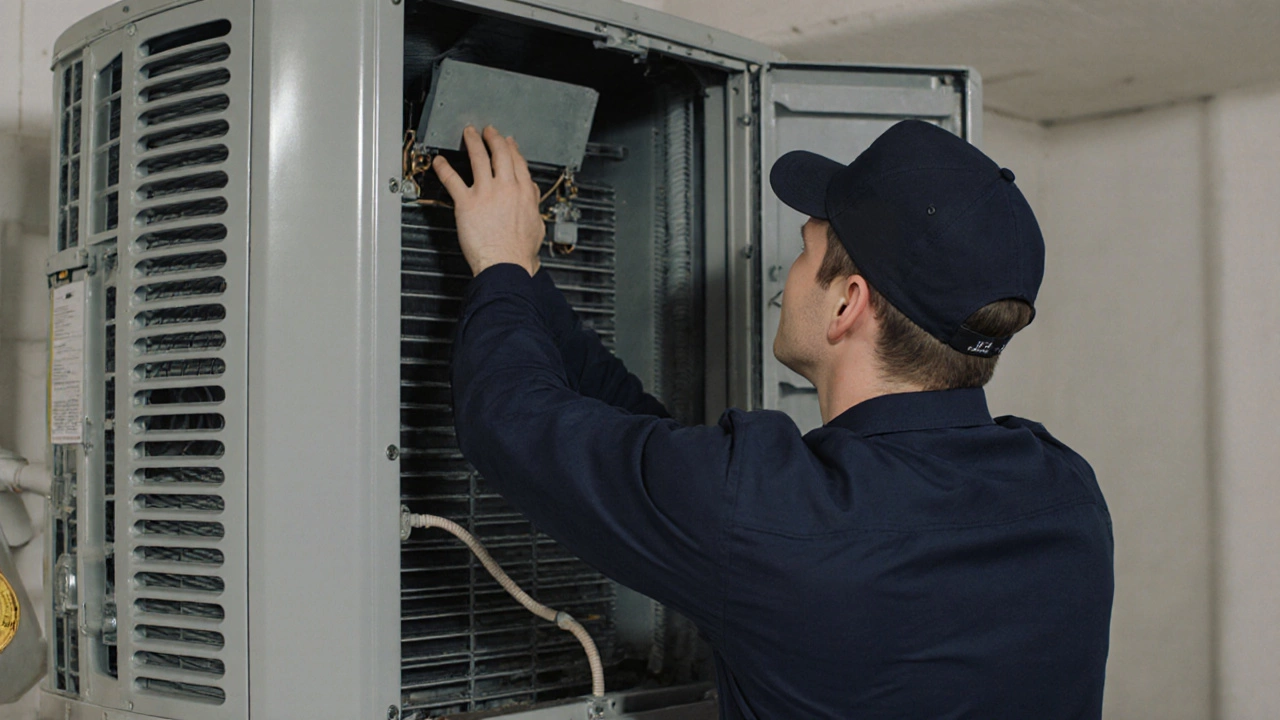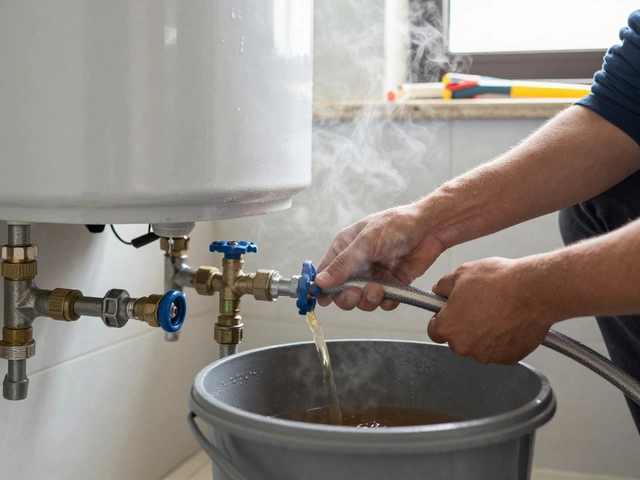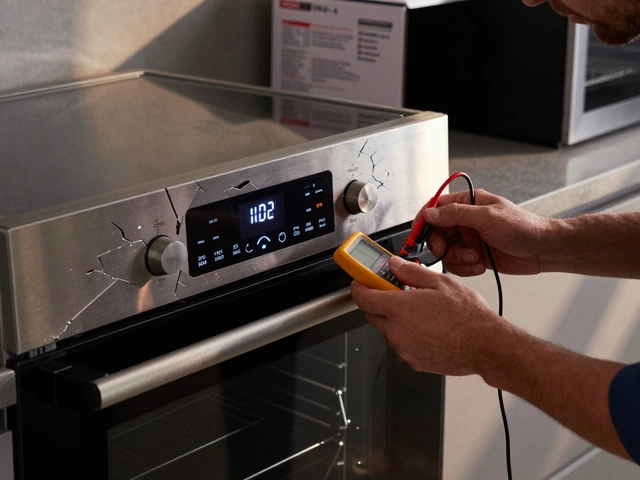If your heat pump is running but the air coming out isn’t cool, you’re not alone. It’s one of the most common complaints during Wellington’s warm summer days. You hear the unit humming, the fan spinning, but the room stays stuffy. That’s frustrating-and it’s usually not as complicated as you think. Most of the time, it’s something simple you can fix yourself before calling a technician.
Check the thermostat settings first
Before you start tearing into the unit, double-check your thermostat. It’s easy to accidentally switch from cool to heat or fan only. Some models have separate mode buttons, others use a dial. Look closely. If it’s set to "fan," the blower runs but no cooling happens. The compressor stays off. That’s normal. Make sure it’s set to "cool" and the temperature is at least 2°C lower than the current room temperature. If you’ve got a smart thermostat, check the app. Sometimes updates glitch and reset modes overnight.Dirty air filter is the #1 culprit
A clogged air filter is the most common reason heat pumps run without cooling. Dust builds up over time, especially in Wellington’s coastal air with salt and pollen. When airflow drops, the evaporator coil freezes over. Ice blocks refrigerant flow. The fan keeps blowing, but it’s just moving air over frozen coils-no cooling happens. Check your filter. If it’s gray or you can’t see light through it, replace it. Most filters need changing every 3 months. If you’ve got pets or allergies, do it every 2. Keep spares on hand. It’s cheap. A $10 filter can save you a $500 service call.Ice on the outdoor unit? That’s a red flag
Walk outside and look at the outdoor unit. If it’s covered in ice or frost-even in summer-it’s not working right. Heat pumps should never frost up unless it’s below 5°C and in heating mode. Ice on cooling mode means one of two things: low refrigerant or bad airflow. Low refrigerant? That’s a leak. Airflow? Usually from a dirty filter or blocked outdoor vents. Clear leaves, branches, or dirt from around the unit. Give it at least 1 meter of clearance. If the ice doesn’t melt after turning the system off for 2 hours, you’ve got a refrigerant issue. Don’t try to add refrigerant yourself. It’s illegal without a license in New Zealand. Call a registered technician.
Blocked or dirty evaporator coil
Inside your indoor unit, there’s a coil that absorbs heat from your air. Over time, dust, mold, and grease coat it. That insulation stops heat transfer. Even if refrigerant is fine, the coil can’t cool the air. You might notice a musty smell or reduced airflow. Cleaning this coil isn’t a DIY job. It requires special tools and access panels. But you can spot the signs: weak airflow, longer cooling times, or water dripping from the unit (from condensation not draining properly). If you’ve changed the filter and cleared the outdoor unit and it’s still not cooling, this is likely the next step. A professional will clean it with a non-corrosive coil cleaner and flush the drain line.Refrigerant leak? It’s serious
Refrigerant isn’t something that gets "used up." If your heat pump is low on it, there’s a leak. That’s not normal. Leaks happen at joints, valves, or damaged copper lines. Signs? Hissing sound near the outdoor unit, ice buildup, higher electricity bills, and no cooling even with a clean filter and clear airflow. Older units (over 10 years) are more prone to leaks. In New Zealand, only licensed technicians can handle refrigerant. They’ll find the leak with a dye or electronic sniffer, repair it, then recharge the system. Never just top up refrigerant without fixing the leak. It’s wasteful, illegal, and damages the environment. R-410A, the most common refrigerant today, is a potent greenhouse gas.Faulty compressor or capacitor
The compressor is the heart of your heat pump. If it’s failing, the system might still run-the fan spins, the lights turn on-but the refrigerant doesn’t circulate. That means no cooling. A bad capacitor (a small cylindrical part that gives the compressor a startup boost) can cause the same symptom. You might hear a clicking noise when it tries to start, or the unit hums but never kicks into full operation. These parts can’t be tested safely without tools. If you suspect this, turn the system off. Continuing to run it can fry the compressor. Replacement costs between $600-$1,200 depending on the model. If your unit is over 12 years old, consider replacement instead. Newer models are 30-50% more efficient.
Thermostat wiring or sensor issues
Sometimes the problem isn’t the heat pump-it’s the brain telling it what to do. A loose wire, corroded terminal, or failing temperature sensor can send the wrong signal. The thermostat thinks the room is cool, so it shuts off the compressor. But the fan keeps running. Try turning the thermostat to "off," then back to "cool". If the unit still doesn’t respond, test with a different thermostat. Borrow a simple digital one from another room. If it works, your old thermostat is faulty. Replace it. Modern thermostats cost $80-$150 and pay for themselves in energy savings.What to do if nothing works
If you’ve checked the filter, cleared the outdoor unit, verified the thermostat, and still no cooling, it’s time to call a pro. But don’t just pick the first ad you see. Look for a technician registered with the Refrigerant Handling Licence from the Ministry for the Environment. Ask if they offer a diagnostic fee waiver if you go ahead with repairs. Get a written quote. Avoid companies that pressure you into replacement without testing. A good technician will show you the ice, measure the refrigerant pressure, and explain why something needs fixing-not just sell you a new unit.Prevention is cheaper than repair
Heat pumps last 10-15 years with proper care. To avoid this headache next summer:- Change the air filter every 2-3 months
- Clear leaves and debris from the outdoor unit monthly
- Don’t block vents with curtains or furniture
- Run the fan on "auto," not "on"
- Get a professional service once a year-preferably in spring before summer hits
A $150 annual service can prevent a $1,000 repair. Most technicians will clean the coils, check refrigerant levels, test electrical connections, and inspect the drain line. It’s like an oil change for your heat pump.
Why is my heat pump blowing air but not cooling?
The most common reason is a dirty air filter. When airflow is restricted, the evaporator coil freezes over. The fan keeps running, but the air passing over the ice doesn’t get cooled. Other causes include low refrigerant, a blocked outdoor unit, or a faulty thermostat. Check the filter first-it’s quick, cheap, and fixes the problem 60% of the time.
Can I add refrigerant to my heat pump myself?
No. In New Zealand, only technicians with a Refrigerant Handling Licence can handle refrigerant. It’s illegal and dangerous to do it yourself. Refrigerant is under high pressure and can cause frostbite or environmental harm. If your system is low on refrigerant, it means there’s a leak. Adding more without fixing the leak is wasteful and violates environmental regulations.
How often should I service my heat pump?
Once a year is ideal. Spring is the best time-before summer use peaks. A professional service includes cleaning the coils, checking refrigerant levels, inspecting electrical connections, and clearing the drain line. Regular servicing extends the life of your unit, improves efficiency, and prevents costly breakdowns.
Is it worth repairing an old heat pump?
If your heat pump is over 12 years old and needs a compressor or refrigerant repair, replacement is often the better choice. Newer models are 30-50% more energy efficient. A $1,000 repair on a 15-year-old unit might cost less upfront, but you’ll pay more in electricity bills and risk another breakdown soon. Look for energy star-rated units-they save money long-term.
Why does my heat pump make a clicking noise but won’t cool?
A clicking sound usually points to a faulty capacitor. The capacitor gives the compressor the initial boost to start. If it’s weak or dead, the compressor tries to turn on but fails, causing the click. The fan might still run because it’s on a separate circuit. This is a sign the compressor isn’t getting enough power. Turn off the unit and call a technician. Continuing to try can damage the compressor.









